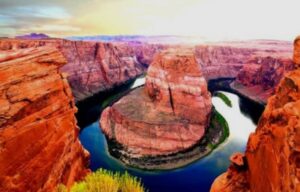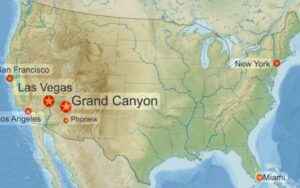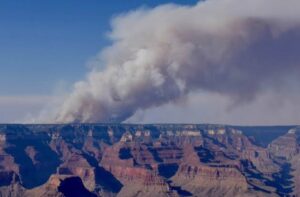Megafire at Grand Canyon : Know Details
Megafire at Grand Canyon : Grand Canyon Blaze Turns into Megafire As the Dragon Bravo wildfire surpasses 115,000 acres, experts warn of unprecedented fire behavior driven by extreme heat, rugged terrain, and dense forests.
How Grand Canyon was Formed ?
The Grand Canyon was formed through a combination of tectonic uplift and erosion by the Colorado River.
Around 50–70 million years ago, the Colorado Plateau rose due to tectonic activity. This uplift increased the river’s gradient, enabling it to cut deeply into rock layers about 5–6 million years ago.
Over time, erosion by water, wind, and sediment deepened and widened the canyon. The arid climate and lack of vegetation accelerated this process.
While some canyon parts may be older, most scientists agree the modern Grand Canyon was primarily carved by the Colorado River in its current path.

What is the News Context of Megafire at Grand Canyon ?
Grand Canyon, August 3, 2025 — A growing wildfire near the North Rim of the Grand Canyon has now ballooned into a megafire, scorching nearly 180 square miles—equivalent to three times the size of Washington, D.C.
Sparked by lightning on July 4, the Dragon Bravo Fire is now the largest active blaze on the U.S. mainland, with only 11% containment as of Saturday.
This environmental disaster, experts say, is a perfect storm fueled by record-breaking dryness, searing temperatures, and the uniquely rugged topography of the Grand Canyon region. Firefighters on the ground are facing one of the most extreme wildfire battles in recent American history.
Why this fire called Megafire at Grand Canyon ?
Wildfires that burn over 100,000 acres are classified as megafires. The Dragon Bravo blaze crossed that threshold earlier this week, driven by persistent drought, winds exceeding 30 mph, and dense vegetation acting as fuel.
“This is not your average wildfire,” says Lisa Jennings, Fire Information Officer with the Southwestern Incident Management Team. “It’s so intense that it’s generating its own weather.”
Fire Creates Its Own Weather System which led to Megafire at Grand Canyon worse
One of the most striking phenomena associated with the fire is the formation of pyrocumulus clouds—also known as “fire clouds.” – These towering clouds form when superheated air and moisture rise rapidly from the flames, reaching altitudes over 24,000 feet.
Once aloft, they can create dangerous downdrafts, lightning, and even firenadoes (fire-induced tornadoes).
“These clouds become like vacuums,” expert explains. “They pull in more smoke, more embers, and can spark new fires miles away. When we see those clouds forming, we often have to pull our crews back for their safety.”
Earlier this week, a brief spell of higher humidity gave firefighters a small window to go on the offensive. But as of Friday, worsening weather has forced a return to defensive strategies.

The Three Deadly Factors: Weather, Terrain, and Fuel behind Megafire at Grand Canyon Incident
The Dragon Bravo fire is growing due to three key factors:
1. Extreme Weather
- The region has experienced over 10 consecutive days of bone-dry conditions, with temperatures climbing into triple digits.
- With no significant rain in sight, firefighters are battling against nature itself.
2. Challenging Terrain
- The Grand Canyon’s iconic landscape is proving to be a firefighter’s nightmare.
- The “finger canyons” branching off the main gorge act as natural wind tunnels, accelerating flame spread.
3. Dense Vegetation
- The thick pine and juniper forests are acting like tinderboxes.
- “These trees are the fuel, It’s like someone dumping dry wood on a campfire every hour.”
The combination of these three elements has resulted in fire behavior that many seasoned professionals say they’ve never encountered before.

How Technology Used to overcome Megafire at Grand Canyon ?
Due to the inaccessible cliffs and deep canyons, much of the firefighting effort is now airborne.
Helicopters and fixed-wing tankers are being used to drop water and fire retardants on remote sections like Crystal Canyon, where ground crews can’t reach.
A fleet of over a dozen aircraft has been deployed, providing vital aerial support. These include large tankers that release red fire retardant chemicals—used not to extinguish the flames directly, but to create barriers that slow their spread.
“It’s a slow process, But it’s the only way to contain the fire in certain zones until the weather shifts in our favor.”
Environmental Impacts Beyond the Blaze due to Megafire at Grand Canyon
The consequences of this fire will be long-lasting. Experts fear destruction of native wildlife habitats, increased erosion risk, and long-term damage to soil quality.
The Grand Canyon area is home to several endangered species, and many may be at risk due to the scale and speed of the fire.
Smoke from the Dragon Bravo fire has already been detected in neighboring states, worsening air quality in parts of Utah, Nevada, and Arizona.
Health advisories have been issued in multiple counties for vulnerable populations.
“These fires are a symptom of a warming world,” says a National Weather Service spokesperson.
“Longer dry seasons, hotter temperatures, and more lightning strikes are creating the perfect conditions for fires like Dragon Bravo.”
In just the last decade, the number of megafires in the U.S. has more than doubled, and scientists predict even more frequent and severe events in the coming years unless global carbon emissions are reduced.
Latest Examples of Wild Fires in America
Palisades Fire (California)
- Started on January 7, 2025 ; it burned over 23,000 acres in the Los Angeles area, caused significant structural damage, and forced evacuations.
Eaton Fire (California)
- Also started on January 7, 2025 ; it burned around 14,021 acres near Altadena and Pasadena and resulted in fatalities and injuries.
Dragon Bravo Fire (Arizona)
- In July, 2025 ; a lightning-ignited fire near the Grand Canyon’s North Rim became the largest US wildfire in 2025, burning 45,000 acres and destroying structures.
Madre Fire (California)
- Burning over 80,000 acres in the Los Padres National Forest, this was the largest wildfire in California as of mid-July.
Hughes Fire (California)
- Started on January 22, 2025 ; it burned near Castaic Lake and led to evacuations before being contained.
Other significant wildfires:
- Gap Fire (Arizona)
- Border 2 Fire (California)
- Blue Hills Fire (Texas)
Oklahoma Wildfires: In March, 2025; over 20 wildfires burned over 200,000 acres, causing fatalities and injuries.
Minnesota Wildfires: In May, 2025 multiple fires burned over 30,000 acres and damaged structures.
Florida Wildfires: Several fires caused considerable damage in February and March this year.
Contributing factors remains the same like,
- Drought conditions
- High fuel loads (dried vegetation) from previous wet seasons
- Strong winds
- Climate change, making conditions more favorable for wildfires and extending the fire season.
These factors contributed to significant losses of life and property, particularly in the January 2025 Southern California wildfires.
Conclusion
As of now, over 1,200 personnel are deployed to the Dragon Bravo fire, working day and night under extreme conditions.
Their mission is not just to contain the blaze, but to safeguard lives, homes, and one of America’s most iconic natural wonders.
But with containment stuck at 11%, and no rain in the forecast, the battle is far from over.
